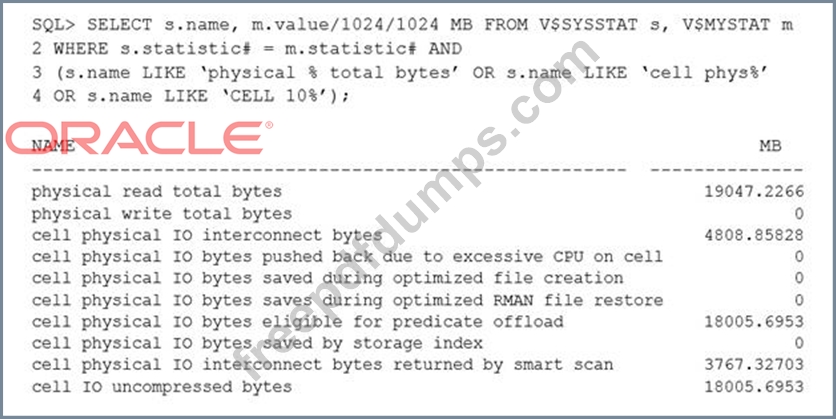1z0-070 Exam Question 6
An Exadata storage server physical disk on an X5 high-capacity full rack entered the predictive failure state.
Identify the two steps that you must perform to replace this failed physical disk.
Identify the two steps that you must perform to replace this failed physical disk.
1z0-070 Exam Question 7
You are evaluating the performance of a SQL statement that accesses a very large table.
You run this query:

Identify two reasons why the "cell physical IO interconnect bytes" statistic is greater than the "cell physical IO interconnect bytes returned by smart scan" statistic.
You run this query:

Identify two reasons why the "cell physical IO interconnect bytes" statistic is greater than the "cell physical IO interconnect bytes returned by smart scan" statistic.
1z0-070 Exam Question 8
You plan to monitor the ASM configuration on an X5 Database Machine as part of your role supporting Exadata-based ASM diskgroups.
You want to check for potential space problems that take ASM mirroring requirements into account.
Which two values would you monitor from V$ASM_DISKGROUP or by using the ASMCMD LSDG command?
You want to check for potential space problems that take ASM mirroring requirements into account.
Which two values would you monitor from V$ASM_DISKGROUP or by using the ASMCMD LSDG command?
1z0-070 Exam Question 9
You plan to partition the database and storage grids in an X5-2 full rack, creating two clusters and two storage grids without using virtualization.
One cluster will be used for production and should consist of six database servers and nine storage servers.
The other cluster will be used for test and development, and should consist of two database servers and five storage servers.
The storage must be partitioned so that the storage servers are visible only to the appropriate database servers that are meant to access them.
What must be done to achieve this?
One cluster will be used for production and should consist of six database servers and nine storage servers.
The other cluster will be used for test and development, and should consist of two database servers and five storage servers.
The storage must be partitioned so that the storage servers are visible only to the appropriate database servers that are meant to access them.
What must be done to achieve this?
1z0-070 Exam Question 10
You issued these commands to all Exadata Storage Servers in an X6 Exadata Database Machine using dcli:
alter iormplan objective = off
alter iormplan active
There are no database or category plans defined.
You are suffering I/O performance problems at certain times, which vary by day and week.
DSS and batch workloads perform well, but your OLTP workloads suffer poor response times when running at the same time as these other workloads.
You must ensure that DSS and batch workloads retain relatively high throughput without causing excessive degradation of OLTP performance.
Which statement would you issue to all Exadata Storage Servers to achieve this?
alter iormplan objective = off
alter iormplan active
There are no database or category plans defined.
You are suffering I/O performance problems at certain times, which vary by day and week.
DSS and batch workloads perform well, but your OLTP workloads suffer poor response times when running at the same time as these other workloads.
You must ensure that DSS and batch workloads retain relatively high throughput without causing excessive degradation of OLTP performance.
Which statement would you issue to all Exadata Storage Servers to achieve this?


